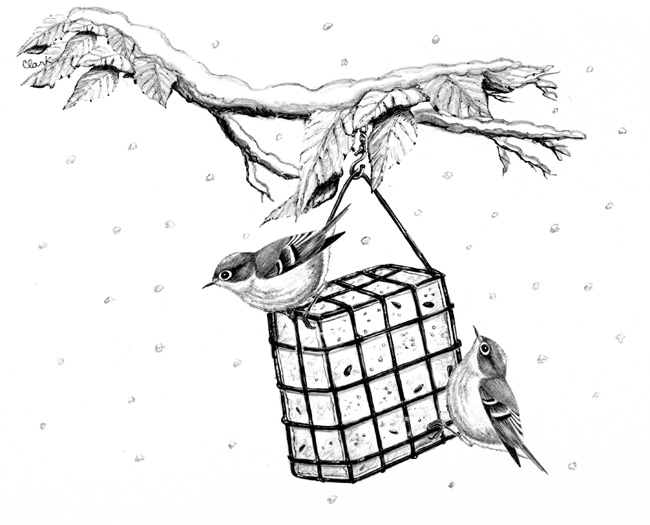
Dear Bird Folks,
I was a little surprised when I looked out the window this morning and found this Ruby-crowned Kinglet (see photo) eating from my feeder. I could see its namesake, “ruby crown,” and everything. Isn’t it unusual to see one of these birds on Cape Cod this time of year?
– Stephanie, Harwich, MA
Nice one, Stephanie,
I have to congratulate you on your photograph. You don’t know how many times I’ve tried to take a decent picture of a kinglet. These highly energetic birds never slow down for anything, especially to pose for me. Anytime I try to take a picture of a kinglet all I end up with is a photograph of an empty branch…where the bird used to be. And what makes your photo even more impressive is that you were able to photograph the Ruby-crowned Kinglet’s ruby crown. I know that sounds like it should be easy, but despite its name, that red crown is hard to see. It’s like the “red belly” on a Red-bellied Woodpecker or a cashier at Sears. It’s there, but you really have to look hard to find it.
Kinglets are one of North America’s smallest birds. They weigh only 1/5 of an ounce, which is half the weight of their obese friends, the chickadees. There are two species of kinglets in world, Ruby-crowned and Golden-crowned, and both can be seen on Cape Cod. Europe also has a few kinglet-type birds, but over there they are called “firecrests” (which I have to admit is a much cooler name). Firecrest sounds like a mystical creature from the Lord of the Rings, while kinglet sounds like a slang term for young males of the Royal Family.
Ruby-crowned Kinglets are lively birds, always in continuous motion and constantly flicking their wings (which is a good field mark to remember). However, these little birds aren’t much to look at. They are mostly olive-gray, with white wing bars and broken eye rings. In other words, they are pretty dull. But as your photo shows, Steph (okay if I call you Steph?) the male kinglet’s bright red head patch does at least give him some color. That’s the good news. The bad news is we rarely get to see this patch. He tends to keeps it hidden, covered up by his dull feathers.
Occasionally though, the bird will flash this red patch, especially during the breeding season or when threatening a predator…or when he is upset at a writer who keeps calling him “dull.” The majority of our kinglets breed in the pine forests of Canada and Alaska. The female does all of the nest building and despite her incredibly small size, she will lay as many as a dozen eggs in a single nest. Like many incubating females, Mrs. Kinglet develops a brood patch, which is an area of exposed skin that provides greater warmth for the eggs. However, she is so tiny and lays so many eggs, her brood patch can’t warm them all, so she uses the heat from her legs to help hatch her eggs. (There’s yet another reason why I like hot legs.)
Canada and Alaska might be a great place to raise a family in the summer, but unless the young kinglets like to snowboard, they will all have to move south when fall arrives. As they migrate toward the Gulf States, many kinglets will stop on the Cape to refuel; thus, October is the best time for us to see them. (Also in April and May when they head back to Canada.) Kinglets spend their days actively hopping through trees searching for spider eggs. In addition, kinglets will also feed hummingbird-style, hovering at the tips of branches, looking for any hiding insects. Because the forest provides all the food they need, kinglets don’t often come to our backyards. But when food becomes buried under snow and ice, like it has lately, these petite birds can suddenly appear at our feeders. What are they looking for? Occasionally, kinglets will eat seeds or berries, but you are most likely to see them eating at a suet feeder. Although their first choice would be a birdfeeder filled with fresh spider eggs, but those are hard to find (like that cashier at Sears).
Is it unusual to see Ruby-crowned Kinglets on Cape Cod in the winter? Yes, it is, Stephanie. Most kinglets are well south of us this time of year. But each year a few stubborn males take a chance and stay a little farther north than they should. Why? Basically, the birds are gambling that the winter will be mild and if it is, they can be the first ones to return to the breeding grounds and thus can claim the best territories. If the winter is particularly harsh, however, these little birds will suffer…just like the rest of us have been since the middle of January.
On a different topic:
After the recent Super Bowl several folks have asked me if there really is a bird called a “Seahawk.” There answer is no, there is no such bird. Perhaps the bird folks in Seattle were thinking of is the Osprey, which is sometimes referred to as a “sea hawk.” But I don’t see the similarity. Ospreys are large birds of prey that feed on fish, typically swallowing huge pieces of food at a time. Seahawks could never swallow huge pieces of anything, at least not the ones from Seattle. They appear to have a problem with choking.